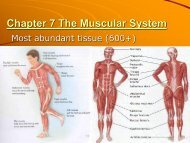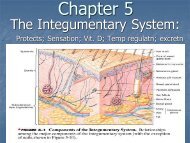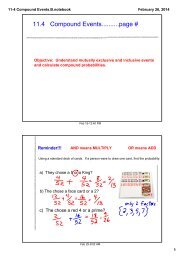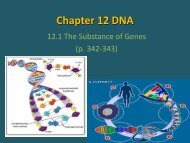Chapter 8 Photosynthesis 2011.pdf
Chapter 8 Photosynthesis 2011.pdf
Chapter 8 Photosynthesis 2011.pdf
You also want an ePaper? Increase the reach of your titles
YUMPU automatically turns print PDFs into web optimized ePapers that Google loves.
<strong>Chapter</strong> 8 <strong>Photosynthesis</strong><br />
8.1 Energy and Life
I. Chemical Energy & ATP<br />
• NRG: ability to do work<br />
a) Many forms of NRG: heat; electricity<br />
b) Chemical bonds store NRG = released w/breakdown<br />
• Candle: wax + O2 = CO2 + H2O (heat/light released)<br />
c) All life obtains, then uses NRG (for cell activities)<br />
• ATP (Adenosine Triphosphate): basic NRG source for cells<br />
• Adenine (N) + Ribose + 3P groups
1. Storing Energy<br />
• ADP (Adenosine Diphosphate):<br />
a) Adenine (N) + Ribose + 2P groups<br />
b) Like a rechargeable battery<br />
c) Available NRG stored by adding 3 rd P group
2. Releasing Energy<br />
• ATP (w/3 P groups)<br />
a) Cells easily break (NRG releasing) and reform (NRG<br />
storing) 3 rd P bond for cellular work<br />
b) Ready to be used, full battery, available NRG
3. Using Biochemical Energy<br />
a) Active Transport: uses ATP to move molecules<br />
• Cell proteins pump Na + /K + in & out to contract muscles<br />
b) Protein synthesis<br />
c) ATP: usable NRG; hard to store; small amts in cell<br />
d) Glucose: un-usable form; 90x the NRG of 1 ATP<br />
e) Cells regenerate ATP from ADP w/NRG in food<br />
w/respiration
II. Heterotrophs & Autotrophs<br />
• <strong>Photosynthesis</strong>: Sun NRG converted to chemical NRG<br />
stored in bonds of carbs<br />
1. Autotroph: use light NRG to make own food (for ATP)<br />
• Ex: Plants, algae, some bacteria<br />
2. Heterotroph: Consumed food NRG to make ATP<br />
• Ex: herbivores/carnivores/decomposers
8.2 <strong>Photosynthesis</strong>: An Overview<br />
I. Chlorophyll and Chloroplasts<br />
1. Light: wavelengths seen as visible spectrum colors
2. Pigments: light-absorbing molecules in<br />
autotrophs<br />
• Chlorophyll a & Chlorophyll b most important<br />
a) Absorbs blue & red regions of visible spectrum best<br />
b) Green NOT absorb but reflect so plants appear green!<br />
c) Cold destroys chlorophyll 1 st ; others (carotene) visible<br />
w/fall
3. Chloroplast: photosynthetic organelle<br />
• Thylakoids: saclike photosynthetic membranes<br />
a) Arranged in stacks called grana<br />
b) Contain chlorophyll, protein & pigments<br />
• Stroma: outer fluid portion
4. Energy Collection:<br />
• Chlorophyll absorbs light and transfers NRG to own electron<br />
molecules<br />
• These high-energy electrons fuel photosynthesis
II. High Energy Electrons (e - ):<br />
• Highly reactive and need special carrier molecule<br />
a) NADP + = nicotinamide adenine dinucleotide phosphate<br />
b) NADP + + 2 e - + H + NADPH<br />
c) NADPH: traps sun NRG into chemical form<br />
d) NADPH: carry e - produced by light absorption to chem rxn in<br />
cell (used to build carbs)
III.Overview of <strong>Photosynthesis</strong>:<br />
• Uses sunlight NRG to convert carbon dioxide and water (reactants) to<br />
sugar and oxygen (products)<br />
a) 6 (CO 2 ) + 6 (H 2 O) C 6 H 12 O 6 + 6 (O 2 )<br />
b) Carbon dioxide + Water Sugars + Oxygen<br />
c) Plants use sugar for NRG and growth
<strong>Photosynthesis</strong>—2 Steps<br />
1) Light-Dependent Reaction<br />
a) Requires light<br />
b) Occurs in thylakoid membranes<br />
c) Uses energy from light to produce ATP & NADPH:<br />
• Light ATP + NADPH<br />
d) O 2 is a by-product
2) Light-Independent Reaction (called Calvin Cycle)<br />
a) Occurs in stroma<br />
b) Does NOT require light<br />
c) Uses ATP & NADPH (from light-dependent) to convert 6 (CO 2 )<br />
molecules into 1 high-NRG sugar
Summary Of <strong>Photosynthesis</strong>
8.3 (p. 240) Factors Affecting <strong>Photosynthesis</strong><br />
1. H 2 0 shortage: may slow or stop photo (desert plant have<br />
waxy leaf coating to slow loss)<br />
2. Temperature: best range 0-35 0 C for photosynthetic enzymes<br />
3. Light Intensity: high intensity best up to a point→plant will<br />
reach max photo rate
<strong>Photosynthesis</strong><br />
Light-dependent<br />
reactions<br />
Uses<br />
Takes place in<br />
Includes<br />
Takes place in<br />
Light-independent<br />
reactions<br />
(Calvin Cycle)<br />
H2O<br />
Energy<br />
from<br />
Sunlight<br />
ATP NADPH CO2<br />
To produce<br />
Thylakoid<br />
membranes<br />
Stroma<br />
To produce<br />
ATP<br />
NADPH<br />
O2<br />
of the<br />
ADP<br />
+ P<br />
NADP<br />
High<br />
Energy<br />
Sugars<br />
Chloroplast
















